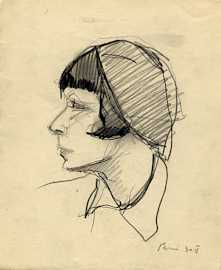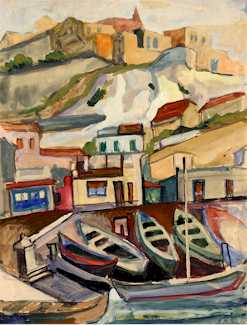|
 The
« Ecole de Paris »
designates a historical fact and not any consistent artistic movement.
This name was created in 1925 by the Art critic André Walnod and was
first used to designate the very many artists who had come from all
horizons and who gathered in Paris from the beginning of the 20th
century to the Second World War, and who made Paris the Capital of the Art
world, open
to all new trends, artistic experience and research. The
« Ecole de Paris »
designates a historical fact and not any consistent artistic movement.
This name was created in 1925 by the Art critic André Walnod and was
first used to designate the very many artists who had come from all
horizons and who gathered in Paris from the beginning of the 20th
century to the Second World War, and who made Paris the Capital of the Art
world, open
to all new trends, artistic experience and research.
Against
nationalism and ambiant xenophobia, this term designated and recognized
the hundreds foreign artists who gathered around the artist studios and
free academies of Montparnasse, around Vavin at the Cafés « Le
Dôme », « La Rotonde » or « Le Select » and who met with the avant-garde pre-war
philosophers, writers and journalists.
Some of them became well-known, others remained in the shadows,
some were recognized in the early days, others had to wait, while yet
others were swept away by the war atrocities before having any chance of
knowing success.
 Amongst
them Amadeo Modigliani from Italy, Picasso from Spain, Foujita from Japan,
Chagall, Kremegne and Kikoine from Russia, Pacsin from Bulgaria, Soutine
from Bielorussia… from 1910 batallions of artists, Jewish or not, chased
from their country by the Russian revolution, by antisemitism or later by
fascism, or else attracted by this creative bubbling centre. Alongside the
triumphant impressionism, the fauvism, expressionism, cubism, the Ecole de Paris remains opened to all expressions. Each artist brings
his own style, his ideas, his sensitivity, his pessimism, his love for
life, his humour. Amongst
them Amadeo Modigliani from Italy, Picasso from Spain, Foujita from Japan,
Chagall, Kremegne and Kikoine from Russia, Pacsin from Bulgaria, Soutine
from Bielorussia… from 1910 batallions of artists, Jewish or not, chased
from their country by the Russian revolution, by antisemitism or later by
fascism, or else attracted by this creative bubbling centre. Alongside the
triumphant impressionism, the fauvism, expressionism, cubism, the Ecole de Paris remains opened to all expressions. Each artist brings
his own style, his ideas, his sensitivity, his pessimism, his love for
life, his humour.
Chagall
replies with a joke when questionned about his oniric world. « That’s
the way it is » with a little gesture of the hand. Kremegene
explains, each one talks about his projects,
his forthcoming exhibitions. All accents and languages can be heard
in the Dôme Café. Pricert feels at home in this atmosphere. He speaks
Italian with some, Russian with others, German with some others, and
French as well. There is no doctrine, no leader. Each one believes in what
he does. Each one doubts. There is laughter, loud talk, they sketch on
bits of paper, they speak in confidence. For those who survived the war
and its tragedies, this period remains the time when everything was
possible. Whatever they chose to do later, whatver their former days were,
this is where they experienced or even tasted what was offered to them.
|